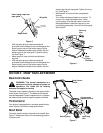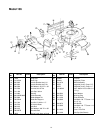
8
SECTION 6: OPERATING YOUR LAWN MOWER
Keep hands and feet away from the chute area on the
cutting deck. See safety labels on page 4.
The operation of any lawn mower can result in foreign
objects being thrown into the eyes, which can result in
severe eye damage. Always wear safety glasses or eye
shields. We recommend wide vision safety mask for
over spectacles or standard safety glasses.
NOTE: For best results raise the cutting position until it
is determined which height is best for your lawn. See
Cutting Height Adjustment section.
Gas And Oil Fill-Up
Service the engine with gasoline and oil as instructed in
the separate engine manual. Read instructions
carefully.
WARNING: Never fill fuel tank indoors,
with engine running or until the engine has
been allowed to cool for at least two
minutes after running.
Before Starting
• Attach spark plug wire to spark plug. If equipped
with a rubber boot, make certain the metal loop on
the end of the spark plug wire (inside the rubber
boot) is fastened securely over the metal tip on the
spark plug.
To Start Engine and Engage Blade
• Prime engine as instructed in the engine manual.
• Standing behind the unit, depress the blade control
handle and hold it against the upper handle.
• Grasp starter handle and pull rope out slowly until
engine reaches start of compression cycle (rope
will pull slightly harder at this point). Let the rope
rewind slowly.
• Pull rope with a rapid, continuous, full arm stroke.
Keep a firm grip on starter handle. Return it slowly
to the rope guide.
NOTE: If you encounter any problems, refer to the
Trouble Shooting Guide for helpful information.
Stop Engine And Blade
• Release the blade control handle to stop the engine
and blade.
WARNING: The blade continues to rotate
for a few seconds after the engine is shut
off. Do not touch the blade in any way
while it is still rotating.
• Disconnect the spark plug wire and ground it
against the engine to prevent accidental starting
while equipment is unattended.
Using Your Rotary Mower
• Be sure that lawn is clear of stones, sticks, wire, or
other objects which could damage lawn mower or
engine. Such objects could be accidently thrown by
the mower in any direction and cause serious
personal injury to the operator and others.
• For best results, do not cut wet grass because it
tends to stick to the underside of the mower,
preventing proper discharge of grass clippings, and
could cause you to slip and fall. New grass, thick
grass or wet grass may require a narrower cut.
Speed of the mower should be adjusted to the
condition of the lawn.
• When using the side-discharge mower, the best
mowing pattern is one that allows the clippings to
discharge towards the uncut part of the lawn. This
permits recutting of the clippings to further pulverize
them. When cutting high weeds, discharge towards
cut portion, then recut at right angles to first
direction.
• For a healthier lawn, always cut off one-third or less
of the total length of the grass. Lawn should be cut
in the fall as long as there is growth.
WARNING: If you strike a foreign object,
stop the engine. Remove wire from spark
plug, thoroughly inspect the mower for
any damage, and repair the damage before
restarting and operating the mower.
Extensive vibration of the mower during
operation is an indication of damage. The
unit should be promptly inspected and
repaired.


















